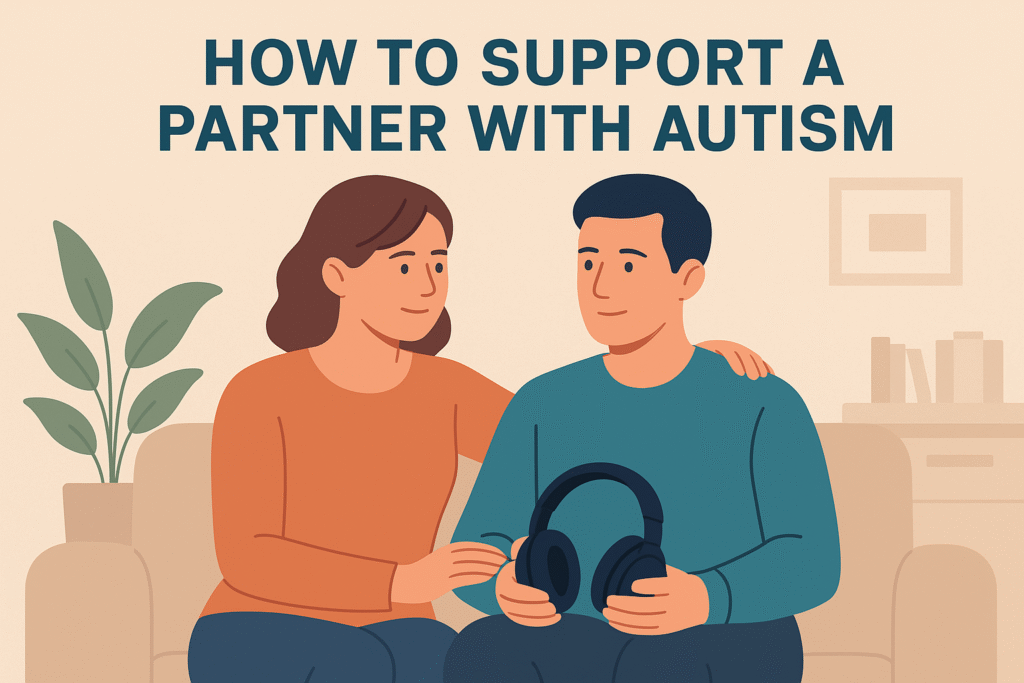
⚠️ Affiliate Disclaimer: This post may contain affiliate links, which means I may earn a small commission — at no extra cost to you — if you make a purchase through one of these links. I only recommend products or services I genuinely trust and believe can provide value. Thank you for supporting My Medical Muse!
10 Powerful Ways to Support a Partner with Autism in Everyday Life
How to Support a Partner with Autism: A Comprehensive Guide
Relationships require patience, communication, and understanding, when one partner is on the autism spectrum, these qualities become even more essential but the rewards can be extraordinary. Autistic individuals bring unique perspectives, deep loyalty, and refreshing honesty to relationships. However, the differences in communication styles, sensory needs, and daily routines may create challenges if left unacknowledged.
Whether you are new to a relationship with an autistic partner or have been together for years, learning how to support them will strengthen your bond, foster mutual respect, and help both of you thrive. This guide offers practical strategies, emotional insights, and actionable tips for supporting a partner with autism.
Understanding Autism in Relationships
What Autism Is, and Isn’t
Autism Spectrum Disorder (ASD) is a neurodevelopmental difference that influences how people perceive, communicate, and interact with the world. It’s called a spectrum because autism presents differently in each individual. Some people may need high levels of support, while others live independently but still navigate unique challenges.
Key features often include:
- Communication differences: Many autistic people prefer clear, direct, and literal language. Sarcasm, implied meaning, or vague hints can be confusing or stressful.
- Sensory sensitivities: Bright lights, loud noises, certain textures, or strong smells may be overwhelming. Environments that seem “normal” to others can feel chaotic or even painful.
- Routine and predictability: Consistent schedules, rituals, and familiar patterns bring comfort. Sudden changes may cause anxiety or stress.
- Special interests: Deep passions, whether it’s astronomy, trains, art, or a video game can be sources of joy and expertise. These interests might dominate conversations, but they’re also a window into your partner’s world.
It’s vital to understand that autism is not a flaw to be corrected. It is a valid way of experiencing and engaging with life. Supporting an autistic partner isn’t about changing them, it’s about appreciating their strengths, accommodating differences, and navigating challenges together as a team.
Also Read: Everything You Need To Know About Autism
Common Misunderstandings
Sometimes neurotypical partners misread autistic behaviors. What may look like disinterest, aloofness, or rudeness is usually something entirely different:
- Limited eye contact: This doesn’t mean your partner isn’t paying attention. In fact, avoiding eye contact can help them concentrate better on what you’re saying without sensory overload.
- Needing alone time: Withdrawal after social events or stressful situations is not rejection. It’s a way of recharging after emotional or sensory exhaustion.
- Direct honesty: Saying things plainly, sometimes bluntly is not meant to hurt feelings. For many autistic people, clear and truthful communication is an expression of respect.
By reinterpreting these behaviors through the lens of autism, you’ll avoid unnecessary hurt and instead respond with compassion and patience.
Building Strong Communication
Communication is the foundation of any relationship, but when one partner is autistic, it requires intentional strategies by being clear, respectful, and adaptive, you can avoid misunderstandings and create a safe space for authentic connection.
Speak Clearly and Directly
Subtle hints, vague requests, or passive aggressive comments may not land the way you intend. Direct communication is often the most supportive approach.
- Instead of: “It would be nice if someone helped with the dishes”, Try “Could you please wash the dishes tonight?”
This clarity removes uncertainty and prevents frustration for both of you. Over time, being straightforward becomes second nature and builds mutual trust.
Use Multiple Channels
Verbal conversations aren’t always the easiest for autistic individuals, especially when emotions run high. Consider expanding how you communicate:
- Text messages: Great for reminders, clarifications, or sharing sensitive thoughts.
- Written notes or lists: Help with daily tasks, chores, or shopping so nothing is lost in translation.
- Shared calendars or apps: Reduce the stress of forgotten plans and give both partners a sense of structure.
When you provide multiple ways to engage, you give your partner more control over how they process and respond.
Practice Active Listening
Listening well is just as important as speaking clearly. To support your autistic partner:
- Give space for processing: Don’t rush to fill silences. Sometimes your partner may need a moment to organize their thoughts.
- Validate feelings: Even if their reaction seems disproportionate to you, acknowledge it as real and meaningful to them. For example: “I understand that the loud noise was overwhelming for you.”
- Reflect for clarity: Repeat back what you heard in your own words: “So what I’m hearing is that you’d like more notice before plans change, did I get that right?”
This shows that you value their perspective and want to truly understand, not just respond.
Communication with an autistic partner thrives on clarity, patience, and mutual respect. When you adapt your style, you’re not “doing all the work”, you’re building a stronger bond where both of you feel heard and understood.
Respecting Sensory Needs
Create a Comfortable Environment
Many autistic individuals live with heightened sensory sensitivity. Everyday details that go unnoticed by others, like the hum of a refrigerator, the flicker of a fluorescent light, or the roughness of certain fabrics can feel distracting, uncomfortable, or even painful.
You can make life easier for your partner by thoughtfully adapting the environment:
- Adjust lighting: Replace harsh overhead lights with soft lamps or natural lighting. Dimmer switches or warm-toned bulbs can also reduce visual strain.
- Minimize noise: Keep background TV or music at a manageable volume. Offering noise-canceling headphones or a quiet space can help during overwhelming times.
- Be mindful of textures and scents: Some autistic individuals find certain fabrics itchy or certain scents overpowering. Choose bedding, clothing, and household products that prioritize comfort and neutral smells.
- Create sensory-friendly zones: Having a designated corner or room with calming items, weighted blankets, soft pillows, or favorite stim toys can become a safe retreat when needed.
These small adjustments may seem simple, but they make a huge difference in creating a home environment that feels safe and restorative rather than stressful.
Respect Boundaries During Overload
When sensory input becomes too intense, your partner may reach a point of overload. This can look like irritability, shutting down, or needing to retreat. Recognizing and respecting this is key to being supportive.
Here’s how to respond helpfully:
- Offer reassurance: Simple, affirming words like “It’s okay, take the time you need” show understanding.
- Provide quiet space: Make sure they know it’s acceptable to step away without judgment. Even five minutes of silence in another room can help reset.
- Don’t take it personally: Overload isn’t about you, it’s a response to overwhelming stimuli. Viewing it this way reduces unnecessary conflict.
- Support recovery: Afterward, ask gently what helped or what could be done differently next time. This builds trust and future preparedness.
Allowing your partner this space is not emotional distance, it’s one of the most caring things you can do.
Supporting Emotional Well-Being
Understand Emotional Regulation
Emotions can feel particularly intense for autistic individuals. They might:
- Shut down: Becoming quiet, withdrawn, and less responsive.
- Melt down: An overwhelming release of emotions that may look like crying, shouting, or pacing.
These are not signs of immaturity or a lack of love, they are natural coping mechanisms when the nervous system is overloaded.
Ways you can support your partner include:
- Stay calm: Your steadiness can prevent the situation from escalating.
- Give space: If they ask for time alone, respect it. Pushing for immediate discussion may backfire.
- Reflect together later: Once the intensity has passed, ask what support they’d like next time. Maybe it’s stepping outside together, maybe it’s simply waiting quietly by their side.
By viewing shutdowns and meltdowns as stress responses not personal attacks, you’ll be able to support them with empathy rather than frustration.
Encourage Self-Care
Supporting emotional well-being also means helping your partner prioritize their needs. Gentle encouragement (not pressure) goes a long way:
- Adequate rest: Respect their need for downtime. What may look like “laziness” is often essential recovery.
- Special interests: These aren’t just hobbies, they are sources of joy, relaxation, and self-expression. Show interest and celebrate their passions.
- Therapy or support groups: If they’re open to it, professional support or connecting with other autistic adults can provide valuable strategies and reduce isolation.
By encouraging self-care, you’re not “fixing” your partner, you’re showing that their happiness and stability matter as much as your own.
Navigating Daily Life Together
Routine and Flexibility
Predictability brings comfort to many autistic individuals. Routines can provide structure and reduce anxiety, but life inevitably brings change. Striking a balance between consistency and adaptability is key.
You can help by:
- Keeping routines consistent: Meals, bedtimes, or weekly rituals can provide grounding stability.
- Giving advance notice: If plans change, share updates as early as possible to allow time for adjustment.
- Using tools for clarity: Visual schedules, calendars, or reminders can reduce uncertainty.
At the same time, build strategies for handling the unexpected:
- Have “calm kits” ready (headphones, fidgets, or comfort items) when out in public.
- Practice grounding techniques together (like breathing exercises) for stressful moments.
- Create backup plans e.g., agreeing in advance how to handle canceled events or surprise visitors.
This dual approach, routine plus flexibility helps your relationship feel steady without being rigid.
Sharing Responsibilities
A common challenge in relationships is division of labor. For autistic partners, vague expectations can cause confusion or stress, being specific and fair reduces conflict.
Practical strategies include:
- Writing things down: Instead of saying “Can you help around the house more?”, make a list and divide tasks clearly.
- Breaking tasks into steps: “Do the laundry” may be overwhelming, but “separate clothes, run the machine, fold, put away” feels more manageable.
- Leveraging strengths: If grocery shopping is too overwhelming due to crowds and sensory input, maybe you handle that while your partner takes charge of cooking or paying bills.
This isn’t about one partner carrying the load, it’s about building a system where both contribute in ways that play to their abilities. Over time, this shared approach strengthens teamwork and prevents resentment.
Respecting sensory needs, supporting emotional well-being, and navigating daily life together are not just accommodations, they are acts of love. These practices create a partnership where both people feel safe, respected, and empowered to thrive.
Intimacy and Relationships
Physical Intimacy
For many autistic individuals, sensory sensitivities shape how they experience physical closeness. Touch, sound, or even the pressure of a hug may feel overwhelming at times. This doesn’t mean they don’t desire intimacy, it simply means the experience may need to look a little different.
Ways you can support your partner include:
- Always ask for consent: Even small gestures like a hug, kiss, or hand on the shoulder should be preceded by clear consent. This reinforces safety and respect.
- Notice non-verbal cues: If your partner stiffens, pulls away, or looks uncomfortable, take it seriously. It’s not rejection, it’s self-protection.
- Explore alternative expressions of affection: Physical intimacy doesn’t have to mean cuddling or long hugs. Holding hands, brushing shoulders as you pass, verbal affirmations, small gifts, or acts of service (like making their favorite tea) can all be meaningful expressions of love.
- Create comfort through communication: Ask directly: “Do you prefer a light touch or a firmer hug?” or “Would you like me to sit close, or do you want space?” This removes guesswork and helps intimacy feel safe.
Remember, intimacy is not about doing what’s “typical,” but about finding what feels good and meaningful for both of you.
Emotional Intimacy
Love may not always be expressed in the “movie script” way you expect. An autistic partner might not say “I love you” every day, but they may show love by:
- Repairing something around the house without being asked.
- Sharing their special interest with you because they trust you with what excites them most.
- Remaining loyal and dependable in ways that bring deep stability to your life.
The key is to reframe how you interpret love. Instead of comparing your partner’s expression of affection to conventional expectations, appreciate the genuine ways they show care. Sometimes the most meaningful gestures are the ones that look quiet but run deep.
Conflict Resolution
Stay Calm and Direct
Conflict is inevitable in any relationship, but arguments can be especially overwhelming for autistic individuals. Raised voices, sarcasm, or emotional ambiguity can cause distress and lead to shutdowns.
To support constructive resolution:
- Speak clearly and calmly: Avoid sarcasm or vague phrasing. Say exactly what the issue is and why it matters to you.
- Focus on one issue at a time: Listing multiple grievances can overwhelm your partner and make it harder to move forward.
- Allow breaks: If the discussion becomes too intense, suggest pausing and returning later. This isn’t avoidance, it’s self-regulation.
Use Problem-Solving Tools
Structured approaches can make difficult conversations easier:
- Write it down: Sometimes putting thoughts on paper before discussing helps both partners organize emotions and avoid miscommunication.
- Schedule discussions: Choose a calm time, not in the heat of the moment.
- Safe words or signals: Agree on a phrase like “time out” that either partner can use to pause the conversation when it becomes overwhelming.
By using these tools, you create a framework where conflict feels manageable instead of explosive, making your relationship more resilient.
Social Life and Family Dynamics
Navigating Social Events
Large gatherings, whether parties, weddings, or family holidays can be overstimulating. Crowds, noise, and unstructured conversations often create stress. Instead of pushing your partner to “just deal with it,” collaborate on strategies:
- Discuss expectations beforehand: Let them know who will be there, what kind of environment to expect, and how long you plan to stay.
- Agree on an exit plan: Decide in advance how they can signal when they’re ready to leave, without judgment.
- Normalize breaks: If they need to step outside or retreat to a quiet room, support them without pressure.
This way, social events become more accessible and less of a source of tension.
Educating Family and Friends
Sometimes loved ones may misunderstand your partner’s behaviors. They might mistake honesty for rudeness, or interpret the need for space as disinterest. You can play an important role in bridging that gap.
Ways to help:
- Explain autism respectfully: Offer simple, strengths-based explanations (e.g., “They’re direct because they value honesty”).
- Advocate gently: If someone criticizes or misreads your partner’s behavior, step in with understanding.
- Encourage respect for routines: Remind family of your partner’s need for predictability or downtime.
Educating others helps create a supportive environment where your partner feels accepted, not judged.
Supporting Growth and Independence
Encouraging Their Strengths
Autistic individuals often have unique talents, whether it’s creativity, problem-solving, technical expertise, or an incredible memory. Too often, focus lands on challenges instead of strengths. As a partner, you can change that narrative.
- Celebrate achievements, even small ones.
- Show interest in their passions, even if they don’t match your own.
- Remind them that their perspective is valuable and enriches your relationship.
Supporting Career and Personal Goals
Independence and growth look different for everyone, but support from a partner can make all the difference. You can help by:
- Offering practical assistance: Help with job applications, role-play interviews, or review emails if requested.
- Respecting work style: If they need frequent breaks, a quiet environment, or strict structure, honor that instead of pushing them to conform.
- Celebrating progress: Whether they got through a tough workday, completed a project, or learned a new skill, recognition goes a long way.
Your encouragement affirms that they are capable, valuable, and worthy not despite autism, but with autism as part of their identity.
Intimacy, conflict resolution, social life, and independence may look different in a relationship where one partner is autistic but different does not mean less meaningful, with empathy, structure, and mutual respect, these areas can become some of the greatest strengths in your partnership.
Taking Care of Yourself
Supporting a partner with autism doesn’t mean neglecting your own needs. A healthy relationship is built on balance.
- Set boundaries: It’s okay to have time for yourself.
- Seek support: Connect with friends, support groups, or therapists who understand neurodiverse relationships.
- Practice self-care: Engage in hobbies, relaxation, and routines that restore your energy.
When you take care of yourself, you’re better equipped to support your partner without resentment or burnout.
When to Seek Professional Help
Sometimes professional guidance can be beneficial:
- Couples therapy with a therapist experienced in autism.
- Individual therapy for managing stress, anxiety, or communication challenges.
- Support groups for partners of autistic individuals.
Professional help is not a failure; it’s a proactive step toward strengthening your relationship.
Conclusion
Supporting a partner with autism is not about fixing them, it’s about understanding, acceptance, and growth together. By embracing clear communication, respecting sensory needs, encouraging emotional well-being, and fostering teamwork, you build a relationship grounded in love and trust.
Every couple’s journey is unique. There will be challenges, but there will also be profound moments of joy, loyalty, and connection that come from loving authentically. When both partners commit to learning and supporting one another, the relationship can flourish in ways that are deeply rewarding.
Your role as a supportive partner is not just about helping, it’s about creating a space where both of you can be fully yourselves, and where love is expressed in ways that feel true, safe, and lasting.
👩⚕️ Need Personalized Health Advice?
Get expert guidance tailored to your unique health concerns through MuseCare Consult. Our licensed doctors are here to help you understand your symptoms, medications, and lab results confidentially and affordably.
👉 Book a MuseCare Consult NowRelated Blog Post You Might Like:
- How Autism in Women Is Different from Men: 10 Powerful Insights
- Autism and Burnout: 7 Powerful Reasons Why It Hits Harder
- Why ADHD Is Often Misdiagnosed as Depression: 7 Powerful Differences You Must Know
- 7 Proven Ways ADHD Affects Sleep and Productivity (And How to Fix It)
- The Hidden Struggle of Masking in Neurodivergent Adults: 10 Shocking Costs You Need to Know
- 10 Early Signs of Autism in Adults You Shouldn’t Ignore


